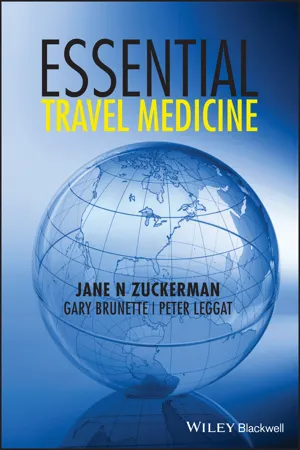The syndrome: clinical definitions, epidemiology, and microbiology
Whereas complex definitions of diarrhea include features such as volume of stool passed, for the purpose of advising travelers, travelers' diarrhea refers to the abrupt onset of passage of unformed (soft – takes the shape of the container; or watery – can be poured) stools, accompanied by nausea, vomiting, abdominal cramps, or low-grade fever. Tenesmus and passage of bloody stools are uncommon but as a rule predict an invasive pathogen such as Shigella. The problem in trying to differentiate between invasive and secretory diarrhea in the differential use of antimicrobial agents in clinical management is overlap of clinical syndromes [1]. Antibiotics cannot logically be limited to invasive pathogens, for instance, because even the archetypical pathogen Shigella often presents with watery diarrhea and not the more typical dysenteric picture that might follow. Diarrhea caused by enterotoxigenic Escherichia coli, a secretory pathogen and the most common cause of travelers' diarrhea in many parts of the world, also responds better to antibiotic-containing regimens rather than antisecretory agents alone [2,3].
The world can be divided into areas with high, intermediate, and low rates; however, the only clinically helpful designation is low rate, because rates in both intermediate- and high-risk areas arguably require the same approach to preparing the traveler to prevent and/or self-treat the syndrome [4]. Basically, low rates are only found in developed countries. High rates of diarrhea for persons traveling from industrialized countries to developing regions are in the order of 40–60% over a 2–3-week vacation. Although most travelers' diarrhea is self-limiting within 3–5 days, a substantial percentage of travelers will change their activities (25%), and some will be confined to bed (15%), which has been a major reason for considering arming the traveler with drugs for self-treatment. Mounting evidence indicates up to a 10% prevalence of irritable bowel syndrome (IBS) that persists for 6 months after a bout of travelers' diarrhea, despite treatment of the initial bout of diarrhea with antimicrobial agents. This, coupled with the largely disappointing status of vaccine prevention of enteric pathogens, has prompted renewed interest in the prevention of the syndrome through education and possibly chemoprophylaxis.
Diarrhea associated with travel can result from multiple causes, including a change in the normal diet, food poisoning (toxins), and infection with viruses (Rotavirus and Norovirus) and parasites (Giardia lamblia, Entamoeba histolytica, and Cryptosporidium). However, bacteria (enterotoxigenic, enteroaggregative, and enteroinvasive E. coli, Shigella, Campylobacter jejuni, and Aeromonas, Salmonella, Vibrio, and Plesiomonas spp., among others) account for the majority of causes. The major causal role of bacteria explains the benefits of antimicrobial agents in the treatment and prevention of the syndrome.
The risk of traveler's diarrhea is highest wherever sanitation, food storage practices, and fuel for cooking are inadequate [5]. Contaminated water appears to be a risk factor for some viruses and parasites, but contaminated food is the most common risk factor among most travelers to the developing world. Inadequate public health practices appear to be a more important risk than contamination of specific food items. As such, the risk of ingesting contaminated food is ubiquitous and travelers find it difficult to prevent diarrhea only by exercising safe beverage and food choices. Nevertheless, travelers should seek locations of food consumption that have an excellent reputation for safety. Clean bottled water is generally readily available in developing countries. Carbonated beverages are inherently safe. Being prepared to use filters, boil water, or disinfect water with iodine is generally not necessary for the average traveler. Piping hot, thoroughly cooked food, dry food, and fruits and vegetables peeled by the traveler are considered generally safe. Tap water, ice cubes, unpasteurized fruit juices or dairy products, fresh salads, cold sauces and toppings, some desserts, open buffets, and undercooked or incompletely reheated foods should be avoided. Most travel medicine experts feel that travelers simply cannot abide by these recommendations and that travelers should be prepared to self-treat. Some experts consider that fluid replacement alone suffices; however, far more experts consider that symptomatic relief afforded by self-treatment with antidiarrheal agents outweighs concerns about side-effects or the theoretical fostering of antimicrobial resistance. The use of antimicrobial prophylaxis, on the other hand, remains a very controversial approach, particularly among European, as compared with North American, travelers [6].
Chemoprophylaxis of travelers' diarrhea
Chemoprophylaxis might be a reasonable strategy for a traveler who is taking a brief trip to a high-risk area and cannot afford to be ill for even a single day [7]. Traditionally, the benefits and safety of chemoprophylaxis with antimicrobials were weighed against obtaining prompt relief of diarrhea by the use of the antisecretory/antimotility agent loperamide, plus an antimicrobial agent. Travelers who might have been offered chemoprophylaxis included competitive athletes, politicians, business travelers, and people going to special events. The confirmation that up to 10% of those developing travelers' diarrhea have symptoms of IBS up to 6 months later and the availability of a safe, minimally absorbed antimicrobial agent, rifaximin, have rekindled interest in the chemoprophylaxis of travelers' diarrhea.
Lactobacillus rhamnosus GG is a safe agent for the prevention of travelers' diarrhea. However, it achieved onl...
